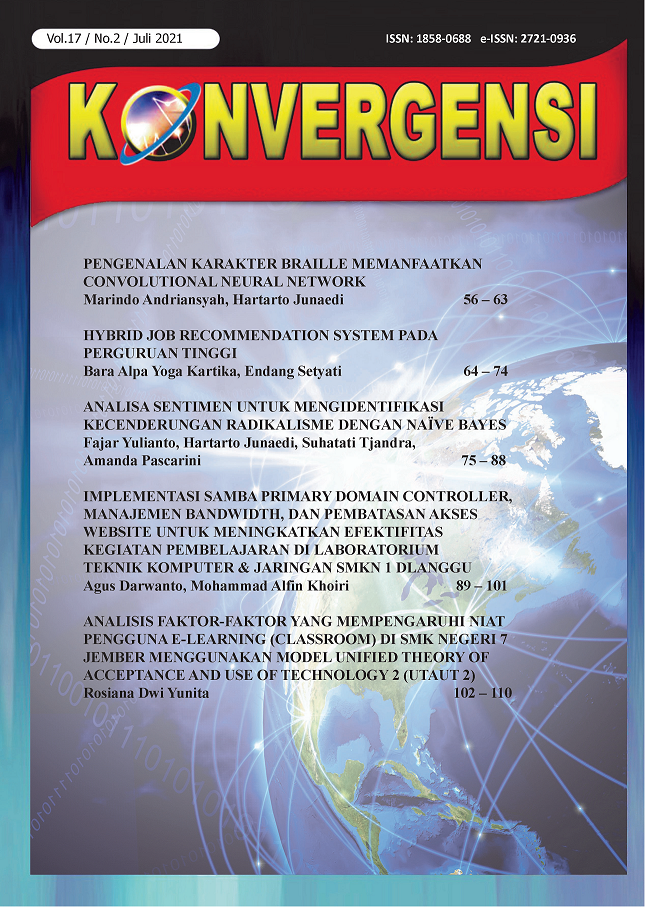ANALISA SENTIMEN UNTUK MENGIDENTIFIKASI KECENDERUNGAN RADIKALISME DENGAN NAÏVE BAYES
DOI:
https://doi.org/10.30996/konv.v17i2.5470Keywords:
sentiment analysis, machine learning, naïve bayes, radikalismeAbstract
ABSTRACT
Radicalism in Indonesia is still an issue that is often discussed considering that there are still many acts of radicalism in Indonesia. The relatively rapid spread of radicalism requires special handling to stop the spread. This study aims to identify radicalism by grouping it into 3 (three) groups or levels which are later expected to facilitate the search for solutions to stop the spread of radicalism. The analysis system will use sentiment analysis using the method of machine learning, namely Naive Bayes. The data used were collected through surveys to students and religious leaders. The Naive Bayes method will later serve to determine the survey results of each individual based on his group. The total data collected for this study amounted to 250 respondents who have filled out survey questions, the data will be divided into 2 types, there are 165 data used for the training phase and 85 data for testing. After processing the data, the results were obtained using classification report calculations and obtained an accuracy of 85% from 3 radical groups.
Keywords: sentiment analysis; machine learning; naïve Bayes; radicalism
ABSTRAK
Radikalisme di Indonesia, hingga saat ini masih menjadi suatu isu yang diperbincangkan mengingat masih banyaknya aksi-aksi radikalisme di Indonesia. Penyebaran paham radikalisme yang relative cepat memerlukan adanya penanganan khusus untuk menghentikan penyebaran tersebut. Penelitian ini bertujuan untuk mengidentifikasi radikalisme dengan mengelompokannya menjadi 3 (tiga) kelompok atau tingkatan yang nantinya diharapkan dapat memudahkan pencarian solusi penghentian penyebaran paham radikalisme tersebut. Sistem analisis akan menggunakan analisis sentiment dengan menggunakan metode dari machine learning yaitu naive bayes. Data yang digunakan sendiri dikumpulkan melalui survey kepada santri dan pemuka agama. Metode naive bayes nantinya akan berfungsi untuk menentukan hasil survey tiap individu tersebut berdasarkan kelompoknya. Total data yang terkumpul untuk penelitian ini berjumlah 250 responden yang sudah mengisi pertanyaan survey, data tersebut nantinya akan dibagi 2 jenis, terdapat 165 data digunakan untuk tahap training dan 85 data untuk testing. Setelah melakukan proses olah data hasil yang didapat menggunakan perhitungan classification report dan didapat akurasi sebesar 85% dari 3 kelompok radikal.
Kata Kunci: sentiment analysis; machine learning; naïve bayes; radikalisme
Downloads
Downloads
Published
Issue
Section
License
Authors whose manuscript is published will approve the following provisions:
- The right to publication of all journal material published on the Konvergensi Teknologi Informasi & Komunikasi website is held by the editorial board with the author's knowledge (moral rights remain the property of the author).
- The formal legal provisions for access to digital articles of this electronic journal are subject to the terms of the Creative Commons Attribution-ShareAlike (CC BY-SA) license, which means Konvergensi Teknologi Informasi & Komunikasi reserves the right to store, modify the format, administer in database, maintain and publish articles without requesting permission from the Author as long as it keeps the Author's name as the owner of Copyright.
- Printed and electronic published manuscripts are open access for educational, research and library purposes. In addition to these objectives, the editorial board shall not be liable for violations of copyright law.







